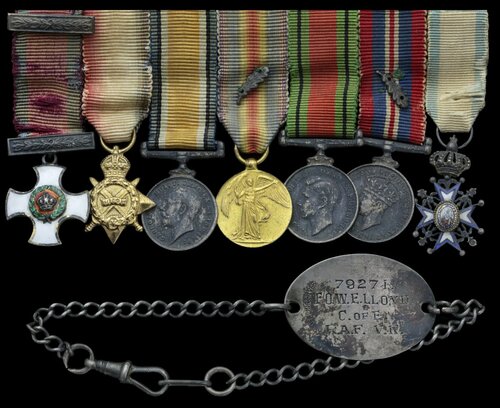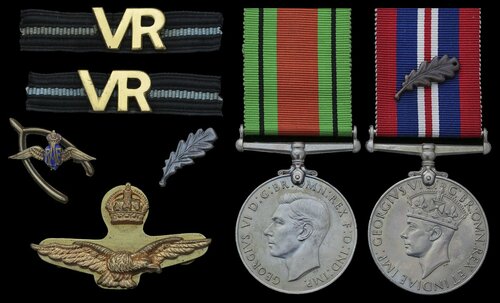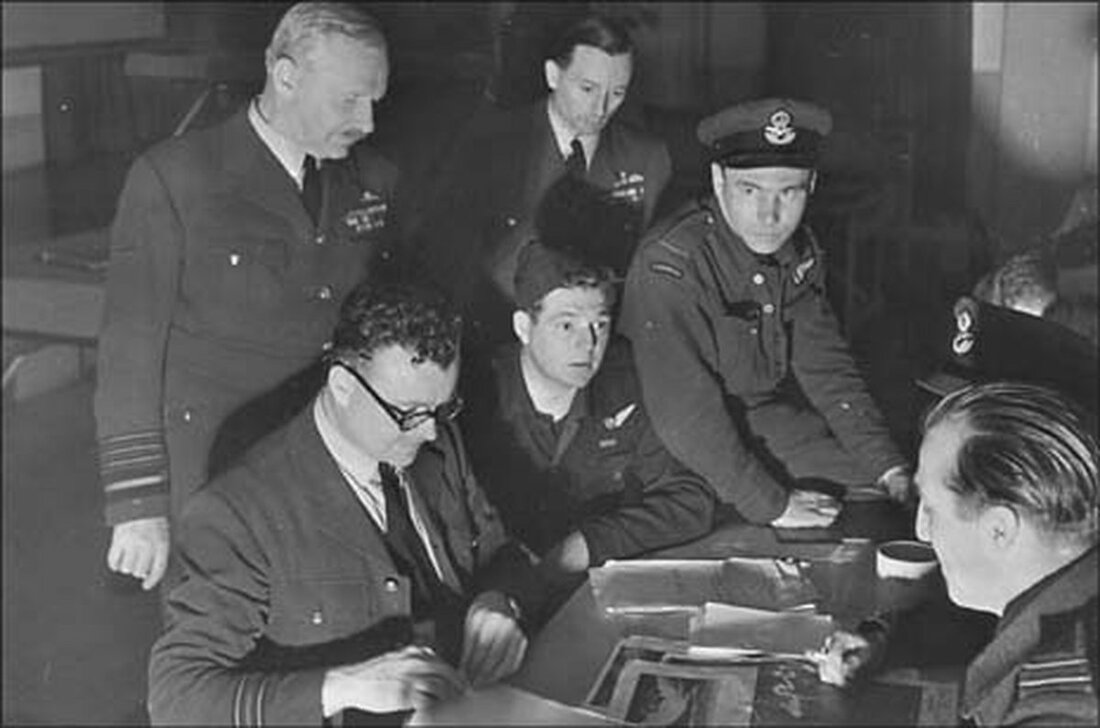Auction: 21003 - Orders, Decorations and Medals
Lot: 608
The mounted D.S.O. group of seven miniature dress medals worn Squadron Leader T. W. ‘Tommy’ Lloyd, Royal Air Force, who served as 617 Squadron’s Intelligence Officer under Guy Gibson, V.C. and Leonard Cheshire, V.C.
Distinguished Service Order, gilt and enamel; 1914-15 Star; British War and Victory Medals, M.I.D. oak leaf; Defence and War Medals 1939-45, with M.I.D. oak leaf; Serbia, Order of St. Sava, silver, gilt and enamel, mounted as worn, together with an ink note stating ‘worn by Auntie Alice at every 617 Reunion and Remembrance Sunday’, minor damage to arm points on the last, otherwise very fine and better
D.S.O. London Gazette 3 June 1918.
M.I.D. London Gazette 15 August 1917, 7 October 1918, 1 January 1943 and 8 June 1944.
Thomas Williams Lloyd served with the 4th Battalion, King's Liverpool Regiment, in France from March 1915, where he was wounded. Afterwards he was appointed Adjutant to a unit of 2,000 Royal Engineers at Liphook for six months, before he joined the mission that evacuated the Serbian Army from Albania to Salonika. He then spent a year in Mesopotamia as personal assistant to General Grey, who ran river transport, and worked out the scheme on which the advance to Baghdad was based. His subsequent award of the D.S.O. was gazetted to him as a Captain (Acting Major), Liverpool Regiment, Special Reserve, employed Royal Engineers, and was the only award listed under the relevant heading.
Towards the end of the war he was transferred to Italy for service in transportation and, after the armistice, was one of a mission of three officers sent by the War Office to report on communications in Hungary and the Adriatic Ports.
On the renewal of hostilities, “Tommy” Lloyd was commissioned into the Royal Air Force Volunteer Reserve, and served as the Intelligence Officer at Woodhall Spa, an appointment that witnessed him acting as I.O. to Guy Gibson’s newly formed “Squadron X”, soon to be retitled No. 617 “Dambuster” Squadron. By all accounts, including Paul Brickhill’s best-selling history, Lloyd was a popular squadron personality and patently a first hand witness to the momentous events of May 1943, not least when he debriefed the returning “Dambusters”.
Gibson, too, mentions him on several times in his classic memoir Enemy Coast Ahead, on one occasion for coming up with the idea of marking targets with incendiaries dropped by crack Beaufighter or Mosquito crews - “their job would be to go in at dusk, just before the main force was due, and drop coloured incendiaries on the factory itself. These could be seen from high up and the boys of the main force would be able to do steady bombing runs which would plaster the area with cookies.” Gibson countered Lloyd’s suggestion with the heavy loss likely to be suffered by the marking force, but noticed that the idea went down well with others, among them “Hoppy” Hopgood.
Sadly, as recounted by Paul Brickhill, “Tommy” Lloyd was killed in a flying accident on 13 February 1944:
‘About the same time the rest of the squadron was landing at Ford in thick weather. Tommy Lloyd, Woodhall intelligence officer, had flown to Ford and de-briefed them, and then the weather worsened and it looked as though they were stranded for a while. [Squadron Leader Bill] Suggitt thought he could make it to Woodhall Spa all right and offered a seat in his aircraft to Lloyd, a gallant and revered World War I veteran. The immaculate Lloyd accepted but insisted on having a shave before take-off. A little later, spruce and monocled, he climbed into “J Jug” with Suggitt, and five minutes later the aircraft flew into a hill and everyone was killed instantly except Bill Suggitt, who lingered for a couple of days before he died.’
Their Lancaster had hit a tree atop Littleton Down, the highest point on the South Downs in Sussex, and instantly spun into the ground. A local farmer found Bill Suggitt strapped in his seat shouting “Turn the engines off,” but he lost consciousness shortly afterwards. Another crew member was Guy Gibson’s Flight Engineer from the dams raid, John Pulford, D.F.M.
Five days later, Wing Commander Cheshire, commanding No. 617 Squadron, wrote to Lloyd’s widow:
‘Dear Mrs. Lloyd,
I have very much wanted to call on you and speak to you in person. Since I have been unable to leave the Station, I am taking this opportunity of writing to you.
Your husband was killed while flying from Ford, in Sussex, back to this Station. He had been down there with the Squadron, as was his usual custom, and having finished his work down there, was on his way back with us. The pilot was a Canadian called Suggitt, an experienced Captain with 64 operations to his credit. I regret to say that they crashed into a hill while flying in cloud. The whole crew died instantly except Suggitt, who, although unconscious, remained alive for two days.
Your husband had been with this Squadron ever since it first formed, and wherever the Squadron went, he went too. He looked after us not only as an Intelligence Officer, but also as a friend, and I don't think that any loss could mean more to us than his. I know there is little I can say that will help you or ease your burden, but I would at least like to tell you something of the influence that Tommy had on all of us. He was somehow a man to whom you could always turn in trouble, and a man who always did so much to make our life happier and more comfortable.
Whereever I may go, I know that I shall meet no-one more tolerant or unselfish, and on behalf of everyone here, as well as myself, I would like to extend to you my great appreciation and gratefulness for all that he did for us, and for the personal sacrifices that he so often made. I would like to extend to you my deepest and most profound sympathy.
Yours sincerely,
G. W. Cheshire
Wing Commander, Commanding No. 617 Squadron.'
Sold together with copied research and the Defence and War Medals 1939-45 issued to his relative Flight Lieutenant W. E. LLoyd (No. 79271), in box of issue sent to 'Flat 14, 22 Basil Street, London SW3.'
Subject to 20% VAT on Buyer’s Premium. For more information please view Terms and Conditions for Buyers.
Sold for
£300
Starting price
£190









